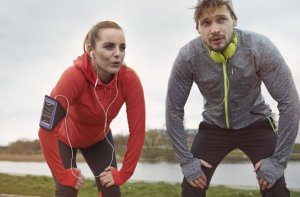The Importance of Breathing in Sports

When starting to practice sports, lots of changes happen in the body. Most of these processes take place to help performance during the activity. Here, we’ll talk about the importance of breathing in sports to help these processes.
When we talk about cardiovascular exercise, one of the most important changes happens in the respiratory system. In this article, we’ll talk about the importance of breathing properly so you can perform better.
Breathing in sports
Breathing is the process by which the respiratory organs exchange the gases necessary for your body to function properly. This process involves these organs:
- Upper airways: formed by the nose and mouth, next to the pharynx and larynx.
- Lower airways: includes the trachea, bronchi and bronchioles.
- Pulmonary parenchyma: with the covering tissue, the pleura, this forms the lungs. This is the organ where the gas exchange takes place. The airways transport the gases to here.
The breathing process is more complex than just breathing in and out. It’s a constant game between negative and positive air pressures. Then, this establishes a gradient between inside and outside factors that help the lungs fill with air. Nitrogen forms most of this, although the essential element for the body is oxygen.
Gas exchange
Through inspiration, air fills the lungs. Oxygen travels through the upper and lower airways to ultimately reach the pulmonary alveolus. In the alveolus is the alveolar-capillary membrane, which brings blood into contact with air.
Due to the difference in the gradient- this time it’s a chemical gradient, which is different from the one we mentioned earlier-, oxygen passes into the blood, and carbon dioxide leaves the blood and into the alveolus. From there, it exits the body through expiration.

Oxygen entering into circulation travels to the left atrium and goes into general circulation by the ventricle in the form of oxygenated blood. This oxygen is the fundamental nutrient for your whole body, and will participate in cellular respiration.
Then, through this process, you get energy in the form of ATP to nourish tissues like muscles. Therefore, breathing in sports is important for optimal physical activity.
Breathing and exercise: a fundamental relationship
During physical exercise, your body needs more oxygen and energy. To nourish the tissues, especially your muscles, you need to increase your heart rate and respiratory rate.
In other words, much more oxygen enters your lungs per minute, making you breathe deeper and more frequently. This way, you can go from a respiratory rate of 15 breaths per minute to 60 per minute during intense exercise.
How does exercise influence breathing?
Playing any type of sport that increases your respiratory rate will directly benefit your lung capacity. Here are some positive effects of breathing in sports:
- Improves lung function. This means that it inflates and deflates more efficiently, which improves gas exchange.
- Also, it makes gas exchange at the alveolar-capillary membrane more efficient by improving the structure of this membrane.
- With cardiovascular improvement, more blood enters the lungs from the right chambers. Then, more alveoli are used than before, which improves basal lung capacity.
- Forced breathing during exercise strengthens the respiratory musculature, resulting in more efficient breathing.
How does breathing influence exercise?
Breathing correctly in sports can help improve performance. Many athletes, especially runners, are concerned with their breathing in sports to optimize their performance.

In addition, the goal is to breathe rhythmically and synchronously. One reason why this improves performance is the Bohr effect.
Simply put, this effect shows that the lungs are able to produce a maximum amount of oxygen. Then, if you increase your respiratory rate from that point, you only breathe out carbon dioxide.
Expelling excess carbon dioxide is inefficient. The Bohr effect is that, at certain concentrations of dioxide in the tissues, they more easily exchange oxygen from the blood cells. Losing too much dioxide means that oxygen doesn’t reach your tissues efficiently.
Breathing in sports is key to performance
Breathing is a more complex process than it sounds. What seems like completely mechanical has deep biochemical bases.
Understanding them, and knowing how to manage them while training, is very important to train successfully. Also, you can improve physical fitness and health through exercise. You must train every little detail to be a better athlete!
When starting to practice sports, lots of changes happen in the body. Most of these processes take place to help performance during the activity. Here, we’ll talk about the importance of breathing in sports to help these processes.
When we talk about cardiovascular exercise, one of the most important changes happens in the respiratory system. In this article, we’ll talk about the importance of breathing properly so you can perform better.
Breathing in sports
Breathing is the process by which the respiratory organs exchange the gases necessary for your body to function properly. This process involves these organs:
- Upper airways: formed by the nose and mouth, next to the pharynx and larynx.
- Lower airways: includes the trachea, bronchi and bronchioles.
- Pulmonary parenchyma: with the covering tissue, the pleura, this forms the lungs. This is the organ where the gas exchange takes place. The airways transport the gases to here.
The breathing process is more complex than just breathing in and out. It’s a constant game between negative and positive air pressures. Then, this establishes a gradient between inside and outside factors that help the lungs fill with air. Nitrogen forms most of this, although the essential element for the body is oxygen.
Gas exchange
Through inspiration, air fills the lungs. Oxygen travels through the upper and lower airways to ultimately reach the pulmonary alveolus. In the alveolus is the alveolar-capillary membrane, which brings blood into contact with air.
Due to the difference in the gradient- this time it’s a chemical gradient, which is different from the one we mentioned earlier-, oxygen passes into the blood, and carbon dioxide leaves the blood and into the alveolus. From there, it exits the body through expiration.

Oxygen entering into circulation travels to the left atrium and goes into general circulation by the ventricle in the form of oxygenated blood. This oxygen is the fundamental nutrient for your whole body, and will participate in cellular respiration.
Then, through this process, you get energy in the form of ATP to nourish tissues like muscles. Therefore, breathing in sports is important for optimal physical activity.
Breathing and exercise: a fundamental relationship
During physical exercise, your body needs more oxygen and energy. To nourish the tissues, especially your muscles, you need to increase your heart rate and respiratory rate.
In other words, much more oxygen enters your lungs per minute, making you breathe deeper and more frequently. This way, you can go from a respiratory rate of 15 breaths per minute to 60 per minute during intense exercise.
How does exercise influence breathing?
Playing any type of sport that increases your respiratory rate will directly benefit your lung capacity. Here are some positive effects of breathing in sports:
- Improves lung function. This means that it inflates and deflates more efficiently, which improves gas exchange.
- Also, it makes gas exchange at the alveolar-capillary membrane more efficient by improving the structure of this membrane.
- With cardiovascular improvement, more blood enters the lungs from the right chambers. Then, more alveoli are used than before, which improves basal lung capacity.
- Forced breathing during exercise strengthens the respiratory musculature, resulting in more efficient breathing.
How does breathing influence exercise?
Breathing correctly in sports can help improve performance. Many athletes, especially runners, are concerned with their breathing in sports to optimize their performance.

In addition, the goal is to breathe rhythmically and synchronously. One reason why this improves performance is the Bohr effect.
Simply put, this effect shows that the lungs are able to produce a maximum amount of oxygen. Then, if you increase your respiratory rate from that point, you only breathe out carbon dioxide.
Expelling excess carbon dioxide is inefficient. The Bohr effect is that, at certain concentrations of dioxide in the tissues, they more easily exchange oxygen from the blood cells. Losing too much dioxide means that oxygen doesn’t reach your tissues efficiently.
Breathing in sports is key to performance
Breathing is a more complex process than it sounds. What seems like completely mechanical has deep biochemical bases.
Understanding them, and knowing how to manage them while training, is very important to train successfully. Also, you can improve physical fitness and health through exercise. You must train every little detail to be a better athlete!
All cited sources were thoroughly reviewed by our team to ensure their quality, reliability, currency, and validity. The bibliography of this article was considered reliable and of academic or scientific accuracy.
- Your lungs and exercise. (2016). Breathe, 12(1), 97–100. https://doi.org/10.1183/20734735.elf121
Lazovic, B., Mazic, S., Suzic-Lazic, J., Djelic, M., Djordjevic-Saranovic, S., Durmic, T., Zikic, D., & Zugic, V. (2015). - Respiratory adaptations in different types of sport. European Review for Medical and Pharmacological Sciences, 19(12), 2269–2274.
- Patel, A. K., & Cooper, J. S. (2018). Physiology, Bohr Effect. In StatPearls. StatPearls Publishing. http://www.ncbi.nlm.nih.gov/pubmed/30252284
This text is provided for informational purposes only and does not replace consultation with a professional. If in doubt, consult your specialist.








